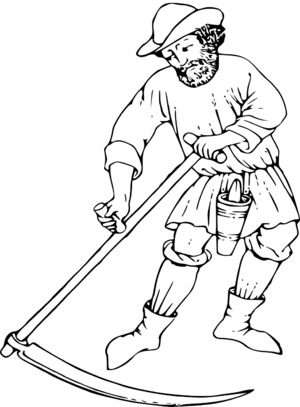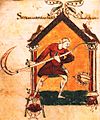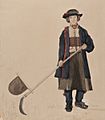Scythe facts for kids
A scythe is a hand tool used for cutting grass or harvesting crops. For a long time, machines like tractors have replaced scythes. But in some parts of Europe and Asia, people still use them.
The word 'scythe' comes from an old English word, siðe. For many years, it was spelled 'sithe' or 'sythe'. Later, people started spelling it 'scythe' because they thought it was linked to a Latin word meaning 'to cut'.
A scythe has a long handle, about 170 cm (67 inches) long. This handle is called a snaith or snath. It was traditionally made of wood, but now it can also be metal. The snaith has one or two shorter handles that stick out. One is usually near the top, and another is in the middle. These handles can be adjusted to fit the person using the scythe.
A curved steel blade is attached to the bottom of the snaith. This blade is usually 60 to 90 cm (24 to 35 inches) long. It is set at about a 90-degree angle to the handle. Most scythes have the blade on the left side, with the sharp edge facing the person using it. Left-handed scythes exist, but they are not used in a team with right-handed ones.
Contents
How to Use a Scythe
Using a scythe is called mowing or scything. The person holds the top handle with their left hand and the middle handle with their right. Their arms are kept straight. The blade should be very close to the ground, parallel to it. The uncut grass should be on the right side.
The mower twists their body to the right. The blade then catches the grass and swings smoothly to the left in a long curve. This movement neatly places the cut grass to the left. The mower then takes a small step forward and repeats the action. This creates a steady rhythm. They stop often to sharpen the blade.
The right way to use a scythe is to slice the grass. Each stroke cuts a narrow strip. This leaves an even stubble on the ground. It also forms a neat row of cut grass, called a windrow, on the left.
The mower moves along the edge of the uncut grass. The cut grass is laid in a neat row on the land that has already been mown. Each strip of ground cut by a scythe is called a swathe. Mowing is easier when the grass is damp. Because of this, hay-making often started at dawn. It would stop early, and the hot part of the day was spent raking hay cut on earlier days.
Scythes are made for different jobs. A long, thin blade (90 to 100 cm or 35 to 39 inches) is best for cutting grass or wheat. A shorter, stronger scythe (60 to 70 cm or 24 to 28 inches) is better for clearing weeds or cutting reeds. It can even be used underwater to clear ditches.
Skilled mowers used to maintain short lawn grass with very sharp, long-bladed scythes. This was before the lawnmower was invented. Many cultures used special frames, called 'cradles', to catch different types of grain stems. These cradles kept the seed heads lined up. This made it easier to bundle them into sheaves and separate the grain from the husks (winnow).
Learning to mow with a scythe takes time and skill. Long-bladed scythes, like those used for grass or wheat, are harder to use at first. Beginners usually start with shorter blades (70 cm or 28 inches or less). Common mistakes for beginners include:
- Setting the handles in the wrong places.
- Setting the blade at the wrong angles.
- Choosing a blade that is too long for their skill level.
- Not starting with a sharp blade or continuing with a dull one.
- Chopping or hacking at the grass instead of slicing.
- Trying to cut too wide a strip of grass at once.
- Hitting the ground with the blade.
Traditionally, new mowers learned from experienced people. These mentors helped them set up and maintain their scythes. They also taught them how to mow comfortably and efficiently.
The Mowing Action
These pictures from 1945 show a man cutting rye with a scythe.
Keeping the Blade Sharp
The sharp edge of a scythe blade is kept in good condition in two ways: by peening and honing.
Peening involves carefully hammering the blade's edge. This reshapes the soft metal, making it stronger and removing small nicks. For cutting fine grass, the edge can be hammered to be very thin. For tougher work, a wider angle is made for a stronger edge. Peening needs some skill and is done with a special hammer and anvils or a peening jig. In the past, people would set up a peening station in the field during harvest. Now, it's usually done in a workshop.
Honing is done more often, using a whetstone (also called a rubber). This keeps the edge very sharp between peening sessions. Mowers carry a whetstone with them in the field. They hone the blade as soon as they feel it getting dull, which might be every half hour.
When honing, a small burr (a tiny raised edge) is created on one side of the blade by stroking the stone on the other side. Then, this burr is gently removed. There are many different ways to do this, depending on regional traditions.
Unlike European blades, American, English, and Nordic scythe blades are made of harder steel. They are usually not peened because they might crack. These harder blades stay sharp longer and need less frequent honing. However, after heavy use, their edge must be reshaped by grinding. This usually only needs to be done a few times a season. Many of these blades have layers: a hard, wear-resistant core for the edge, and softer sides for strength.
Related pages
Images for kids
-
Neolithic rock carving showing scythes from Norway.
-
Niittomiehet (Mower men), a painting by Pekka Halonen, 1891.
-
The Veteran in a New Field by Winslow Homer, 1865.
See also
 In Spanish: Guadaña para niños
In Spanish: Guadaña para niños












